Table of Contents
*
Fan Mail
*
F.I.D.O.: Ludovic Pirani
*
Geronimo's Travels
*
The Breeding and Maintenance of Sledge Dogs: Part I
*
How We Met Tom
*
Dog Yard Tips
*
Setting a New Standard
*
In the News
*
Behavior Notebook: Qiniliq and Sunny
*
IMHO: Unnecessary Roughness
Navigating This
Site
Index of articles by subject
Index
of back issues by volume number
Search The
Fan Hitch
Articles
to download and print
Ordering
Ken MacRury's Thesis
Our
comprehensive list of resources
Talk
to The
Fan Hitch
The Fan
Hitch home page
ISDI
home page
Editor: Sue Hamilton
Webmaster: Mark Hamilton
Contents of The Fan Hitch Website and its publications are protected by international copyright laws. No photo, drawing or text may be reproduced in any form without written consent. Webmasters please note: written consent is necessary before linking this site to yours! Please forward requests to Sue Hamilton, 55 Town Line Rd., Harwinton, Connecticut 06791, USA or mail@thefanhitch.org
by Linda Fredericksen
Preventing Fence Fighting Related Injuries
Unfortunately, fence fighting is a fact of life with some
breeds. Some
Inuit Dogs I know seem to relish this activity. My
kennel is configured
with one very large pen, big enough to comfortably hold up
to seven dogs,
and three smaller pens with gates between each for
different combinations
of pens based on need. These needs consist of a separate
place for dogs
in heat, containment for rescue dogs, puppies, older dogs
or just dogs
in need of some alone time. When our first rescue dog
arrived I didn't
want to take a chance that a possible fence fight would
result in someone
getting hurt. I found the solution at the Wildlife Science
Center north
of Minneapolis-St. Paul in Minnesota. The center keeps a
number of wolves
in high enclosures and, because it allows dogs in the
facility and stages
a number dog related activities, the center has prepared
for the possibility
of resident wolf-visitor dog interaction by fastening
hardware cloth to
the chain link using hog rings.
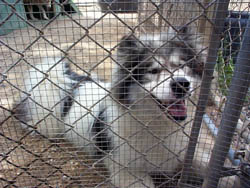
Adja smiles from behind the hardware
cloth reinforced
fencing
Fredericksen
photo
Hardware cloth comes in different heights and different mesh sizes. On the common walls between my pens, I mounted three-foot high material with half inch mesh. In one pen, I installed hardware cloth all the way up the six-foot wall. This material is easy to work with, as the tool needed to install the hog rings fits nicely in the holes. We have a number of young visitors to the dogs and I thought it would be easier and less stressful for me to have this hardware cloth in place. To keep little fingers out of the pens, I used three-foot high cloth with quarter inch square openings for the exterior of the entire kennel. I also have a house dog, a twelve-pound dachshund-poodle cross, and even though my management of the dogs is strict, I felt secure knowing that if the little guy ever found himself near the kennel, he would not be in danger.
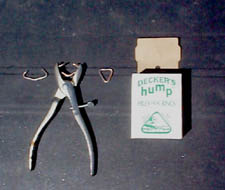
Hog Rings and Hog Ring Plier
Fredericksen
photo
What about gates? For this purpose I use a section of cattle fencing with 6x8-inch openings, made of wire so rigid that it must be cut with bolt cutters. To this I attach the hardware cloth. Then, using brass clips, I secure the entire panel to the gate with an overlap on each side. It stays nicely in place and I merely have to unclip the panel when I want to open the gates to combine pens.
Providing Summertime Shade
When I turned our very large garden into a dog kennel, I
was faced
with the challenge of providing shade for the dogs. A
friend, the owner
of Black Ice Dog Sledding Equipment, offered me the
following solution:
I special ordered an 85% shade landscape cloth from a
local landscaping
supply company. The measurements and design were to my
specifications.
I had the company put a sleeve at one end of the rectangle
and grommets
every twelve inches on the other three sides. I used nylon
rope through
the grommets to attach the cloth to the top rail of the
kennel fencing.
Once cut, the ends of nylon rope must be carefully burned
to prevent fraying
so it can easily pass through the grommets and the sleeve.
I fed a long
piece of nylon rope through the sleeve. Then I tied one
end to the top
rail and secured and tightened the other end by means of a
rope ratchet,
which allows me to maintain tension on the line.
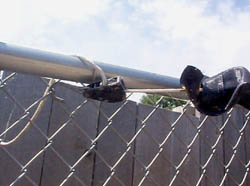
Rope ratchets secure
sides Fredericksen
photo
The shade cloth manufacturer would not make a triangular shape for a sunny corner of the kennel, so I just had them make a square with no sleeve. I folded it over to make the triangle. I secured it the same way except the rope went through two grommets due to the fold.
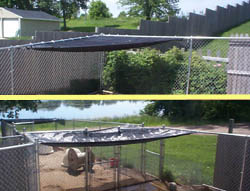
Examples of corner and full width shade
cloth
Fredericksen
photo
Environmental Enrichment
I discovered that my dogs loved the dog walk (wooden ramps
with a level
section in the middle) part of the course at agility
class, so I had ones
custom made for their enjoyment in each kennel. I have two
sizes based
on kennel size. There are nooks and crannies where
they can hide
and ramps on both sides and that long flat area on top
where several dogs
can sun bathe.
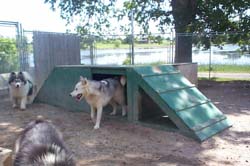
Custom Dog Walk unit Fredericksen photo
Cooling Off
I used to set up flimsy plastic kiddie pools in the
exercise yard like
many dog people do, but got fed up with having to replace
them every year.
Freeland
Industries (PO Box 59, Portage WI 53901 Phone: 608
742-2189, 1-800
444-2189) makes heavy duty "Poly Tuf"™ stock tanks in a
variety of sizes
that double as great doggie pools. These are often
available at farm supply
stores. I put one in every pen because the dogs liked them
so much. The
oval shaped tubs are 14" high by 31" wide by 52" long, and
hold 60 gallons.
The only required maintenance with the tubs is the
constant changing of
water to avoid algae build up. I know there are chemicals
to prevent this
but I don't like the idea of chemicals in the dog pens.
Every few days
I scrub out the tub with a metal pad.
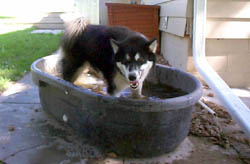
Isis cools her
heels
Fredericksen photo
Have a safe, shady, enriched and cool summer!